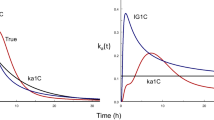Abstract
The plasma concentration–time profiles following oral administration of drugs are often irregular and cannot be interpreted easily with conventional models based on first- or zero-order absorption kinetics and lag time. Six new models were developed using a time-dependent absorption rate coefficient, ka(t), wherein the time dependency was varied to account for the dynamic processes such as changes in fluid absorption or secretion, in absorption surface area, and in motility with time, in the gastrointestinal tract. In the present study, the plasma concentration profiles of propranolol obtained in human subjects following oral dosing were analyzed using the newly derived models based on mass balance and compared with the conventional models. Nonlinear regression analysis indicated that the conventional compartment model including lag time (CLAG model) could not predict the rapid initial increase in plasma concentration after dosing and the predicted Cmax values were much lower than that observed. On the other hand, all models with the time-dependent absorption rate coefficient, ka(t), were superior to the CLAG model in predicting plasma concentration profiles. Based on Akaike's Information Criterion (AIC), the fluid absorption model without lag time (FA model) exhibited the best overall fit to the data. The two-phase model including lag time, TPLAG model was also found to be a good model judging from the values of sum of squares. This model also described the irregular profiles of plasma concentration with time and frequently predicted Cmax values satisfactorily. A comparison of the absorption rate profiles also suggested that the TPLAG model is better at prediction of irregular absorption kinetics than the FA model. In conclusion, the incorporation of a time-dependent absorption rate coefficient ka(t) allows the prediction of nonlinear absorption characteristics in a more reliable manner.
Similar content being viewed by others
REFERENCES
V. S. Patel and W. G. Kramer. Allopurinol absorption from different sites of the rat gastrointestinal tract. J. Pharm. Sci. 75:275–277 (1986).
J. J. Tukker and F. G. J. Poelma. Site-dependent absorption in the rat intestine. Abstract, Third Int. Conf. on Drug Absorption, Edinburgh, p. 45, 1988.
G. L. Amidon, H. Lennernas, V. P. Shah, and J. R. Crison. A theoretical basis for a biopharmaceutic drug classification: The correlation of in v itro drug product dissolution and in vivo bioavailability. Pharm. Res. 12:413–420 (1995).
J. A. Clements, R. C. Heading, W. S. Nimmo, and L. F. Prescott. Kinetics of acetamin-ophen absorption and gastric emptying in man. Clin. Pharmacol. Ther. 24:420–431 (1978).
P. Langguth, K. M. Lee, H. Spahn-Langguth, and G. L. Amidon. Variable gastric empty-ing and discontinuities in drug absorption profiles: Dependence of rates and extent of cimetidine absorption on motility phase and pH. Biopharm. Drug Dispos. 15:719–746 (1994).
S. Haruta, N. Iwasaki, K. Ogawara, K. Higaki, and T. Kimura. Absorption behavior of orally administered drugs in rats treated with propantheline. J. Pharm. Sci. 87:1081–1085 (1998).
R. Sü verkrü p. Discontinuous absorption processes in pharmacokinetic models. J. Pharm. Sci. 68:1395–1400 (1979).
J. J. Zimmerman. Use of Metzler's NONLIN program for fitting discontinuous absorption profiles. J. Pharm. Sci. 72:138–142 (1983).
K. Murata, K. Noda, K. Kohno, and M. Samejima. Pharmacokinetic analysis of concen-tration data of drugs with irregular absorption profiles using multi-function absorption models. J. Pharm. Sci. 76:109–113 (1987).
R. L. Oberle and G. L. Amidon. The influence of variable gastric emptying and intestinal transit rates on the plasma level curve of cimetidine: An explanation for the double peak phenomenon. J. Pharmacokin. Biopharm. 15:529–544 (1987).
T. Sawamoto, S. Haruta, Y. Kurosaki, K. Higaki, and T. Kimura. Prediction of the plasma concentration profiles of orally administered drugs in rats on the basis of gastrointestinal transit kinetics and absorbability. J. Pharm. Pharmacol. 49:450–457 (1997).
B. E. Bleske, L. S. Welage, S. Rose, G. L. Amidon, and M. J. Shea. The effect of dosage release formulations on the pharmacokinetics of propranolol stereoisomers in humans. J. Clin. Pharmacol. 35:374–378 (1995).
Rights and permissions
About this article
Cite this article
Higaki, K., Yamashita, S. & Amidon, G.L. Time-Dependent Oral Absorption Models. J Pharmacokinet Pharmacodyn 28, 109–128 (2001). https://doi.org/10.1023/A:1011573831444
Issue Date:
DOI: https://doi.org/10.1023/A:1011573831444




